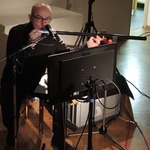
Peter Wießenthaner
Joined over 9 years ago.Bio
1951, composer, multi-media work. After the transverse flute studies turning to the composition with live electronics. Substantially for his work with live electronics a contact with Luigi Nono was in the experimental studio of the SWF in Freiburg. Essential innovation with Wiessenthaner in the play with loudspeaker and microphone: The player controls his play concerning the space-phonic sound himself. Since 1982 a game which shows similarities to the improvisation, shows however clear inclusion and exclusion criteria for the game developed without notes. Since 1982 game with microphone and loudspeaker. Important further development: the player feeds out his tones according to a simple principle even in the volume and room position. Many performances with live electronics, at this a game with up to 8 loudspeakers. Peter Wießenthaner developed the transverse flute into a collection of flutes with the aim of an expansion of the clay room and the tone colors. By unique drilling constellations of the individual flute pipes, the composer achieves a tonal moving and fanning of the nuclear tones. With self-developed ways of playing Wiessenthaner plumbs the tonal parameters like pitch, volume, tone color, duration, articulation newly. Inclusion and exclusion criteria define the frame for the formal expiry. In a game developed this is free the composition of notation. The game tries to establish itself outside the system made the right temperature, the different qualities of the tone are carried out in the game. Notation wouldn't have led to the results which have entered in the course of the years. A clay idea which introduces the tone as a complex event category which takes place at the time came to mind.
The field of work of Peter Wiessenthaner is trans-media. Different representation levels are penetrated with respect to each other and couple themselves back. He works with MAX/ MSP/JITTER, Arduino and with PROCESSING and creates multimedia compositions.The presentation forms go from the concert hall via the showroom to into the virtual space of the Internet. Last work with Processing and MAX/MSP/JITTER
Project in the development: Movement one of two pipes of a big bass Glissando flute by microprocessors. See my website the Glissando transverse flutes are described here. They are moved instead of with the hand by a processor-steered mechanics. The distances for the movement and with it the regulation of the pitches, are achieved by algorithms. The first prototype will be finished September or October, 2016.